Chemistry > AQA QUESTION and MARK SCHEMES > AQA A-level CHEMISTRY 7405/1 Paper 1 Inorganic and Physical Chemistry Question Paper + Mark scheme [ (All)
AQA A-level CHEMISTRY 7405/1 Paper 1 Inorganic and Physical Chemistry Question Paper + Mark scheme [MERGED] June 2022 *JUN227405101* IB/M/Jun22/E11 7405/1 For Examiner’s Use Question Mark 1 2
Document Content and Description Below
AQA A-level CHEMISTRY 7405/1 Paper 1 Inorganic and Physical Chemistry Question Paper + Mark scheme [MERGED] June 2022 *JUN227405101* IB/M/Jun22/E11 7405/1 For Examiner’s Use Question Mark ... 1 2 3 4 5 6 7 8 TOTAL Time allowed: 2 hours Materials For this paper you must have: • the Periodic Table/Data Booklet, provided as an insert (enclosed) • a ruler with millimetre measurements • a scientific calculator, which you are expected to use where appropriate. Instructions • Use black ink or black ball-point pen. • Fill in the boxes at the top of this page. • Answer all questions. • You must answer the questions in the spaces provided. Do not write outside the box around each page or on blank pages. • If you need extra space for your answer(s), use the lined pages at the end of this book. Write the question number against your answer(s). • All working must be shown. • Do all rough work in this book. Cross through any work you do not want to be marked. Information • The marks for questions are shown in brackets. • The maximum mark for this paper is 105. Please write clearly in block capitals. Centre number Candidate number Surname Forename(s) Candidate signature I declare this is my own work. A-level CHEMISTRY Paper 1 Inorganic and Physical Chemistry 2 *02* IB/M/Jun22/7405/1 Do not write outside the There are no questions printed on this page box DO NOT WRITE ON THIS PAGE ANSWER IN THE SPACES PROVIDED 3 *03* Turn over ► IB/M/Jun22/7405/1 Do not write outside the Answer all questions in the spaces provided. box 0 1 This question is about equilibria. 0 1 . 1 Give two features of a reaction in dynamic equilibrium. [2 marks] Feature 1 Feature 2 0 1 . 2 A gas-phase reaction is at equilibrium. When the pressure is increased the yield of product decreases. State what can be deduced about the chemical equation for this equilibrium. [1 mark] Question 1 continues on the next page 4 *04* IB/M/Jun22/7405/1 Do not write outside the box 0 1 . 3 Carbon monoxide and hydrogen react to form methanol. CO(g) + 2H2(g) ⇌ CH3OH(g) 0.430 mol of carbon monoxide is mixed with 0.860 mol of hydrogen. At equilibrium, the total pressure in the flask is 250 kPa and the mixture contains 0.110 mol of methanol. Calculate the amount, in moles, of carbon monoxide present at equilibrium. Calculate the partial pressure, in kPa, of carbon monoxide in this equilibrium mixture. [3 marks] Amount of carbon monoxide mol Partial pressure kPa 0 1 . 4 Give an expression for the equilibrium constant (Kp) for this reaction. CO(g) + 2H2(g) ⇌ CH3OH(g) [1 mark] Kp 5 *05* Turn over ► IB/M/Jun22/7405/1 Do not write outside the box 0 1 . 5 A different mixture of carbon monoxide and hydrogen is left to reach equilibrium at a temperature T. Some data for this equilibrium are shown in Table 1. Table 1 Partial pressure of CO 125 kPa Partial pressure of CH3OH 5.45 kPa Kp 1.15 x 10–6 kPa–2 CO(g) + 2H2(g) ⇌ CH3OH(g) Calculate the partial pressure, in kPa, of hydrogen in this equilibrium mixture. [3 marks] Partial pressure kPa 0 1 . 6 Use the Kp value from Table 1 to calculate a value for Kp for the following reaction at temperature T. CH3OH(g) ⇌ CO(g) + 2H2(g) Give the units for Kp [2 marks] Kp Units 12 6 *06* IB/M/Jun22/7405/1 Do not write outside the box 0 2 Rhenium has an atomic number of 75 0 2 . 1 Define the term relative atomic mass. [2 marks] 0 2 . 2 The relative atomic mass of a sample of rhenium is 186.3 Table 2 shows information about the two isotopes of rhenium in this sample. Table 2 Relative isotopic mass Relative abundance 185 10 To be calculated 17 Calculate the relative isotopic mass of the other rhenium isotope. Show your working. [2 marks] Relative isotopic mass 0 2 . 3 State why the isotopes of rhenium have the same chemical properties. [1 mark] 7 *07* Turn over ► IB/M/Jun22/7405/1 Do not write outside the box A sample of rhenium is ionised by electron impact in a time of flight (TOF) mass spectrometer. 0 2 . 4 A 185Re+ ion with a kinetic energy of 1.153 × 10−13 J travels through a 1.450 m flight tube. The kinetic energy of the ion is given by the equation KE = 1 2 mv 2 where m = mass / kg v = speed / m s–1 KE = kinetic energy / J Calculate the time, in seconds, for the ion to reach the detector. The Avogadro constant, L = 6.022 × 1023 mol−1 [5 marks] Time s 8 *08* IB/M/Jun22/7405/1 Do not write outside the box 0 2 . 5 State how the relative abundance of 185Re+ is determined in a TOF mass spectrometer. [2 marks] 12 9 *09* Turn over ► IB/M/Jun22/7405/1 Do not write outside the Turn over for the next question box DO NOT WRITE ON THIS PAGE ANSWER IN THE SPACES PROVIDED 10 *10* IB/M/Jun22/7405/1 Do not write outside the box 0 3 This question is about hydrogen peroxide, H2O2 The half-equation for the oxidation of hydrogen peroxide is H2O2 O2 + 2H+ + 2e– Hair bleach solution contains hydrogen peroxide. A sample of hair bleach solution is diluted with water. The concentration of hydrogen peroxide in the diluted solution is 5.00% of that in the original solution. A 25.0 cm3 sample of the diluted hair bleach solution is acidified with dilute sulfuric acid. This acidified sample is titrated with 0.0200 mol dm−3 potassium manganate(VII) solution. The reaction is complete when 35.85 cm3 of the potassium manganate(VII) solution are added. 0 3 . 1 Give an ionic equation for the reaction between potassium manganate(VII) and acidified hydrogen peroxide. Calculate the concentration, in mol dm–3, of hydrogen peroxide in the original hair bleach solution. (If you were unable to write an equation for the reaction you may assume that the mole ratio of potassium manganate(VII) to hydrogen peroxide is 3:4 This is not the correct mole ratio.) [5 marks] Concentration mol dm–3 11 *11* Turn over ► IB/M/Jun22/7405/1 Do not write outside the box 0 3 . 2 State why an indicator is not added in this titration. [1 mark] 0 3 . 3 Give the oxidation state of oxygen in hydrogen peroxide. [1 mark] 0 3 . 4 Hydrogen peroxide decomposes to form water and oxygen. Give an equation for this reaction. Calculate the amount, in moles, of hydrogen peroxide that would be needed to produce 185 cm3 of oxygen gas at 100 kPa and 298 K The gas constant, R = 8.31 J K−1 mol−1 [5 marks] Equation Amount mol 12 *12* IB/M/Jun22/7405/1 Do not write outside the box 0 3 . 5 Hydrazine (N2H4) is used as a rocket fuel that is oxidised by hydrogen peroxide. The equation for this reaction in the gas phase is The enthalpy change for this reaction, ∆H = –789 kJ mol−1 Table 3 shows some mean bond enthalpy values. Table 3 N–H N–N N≡N O–H Mean bond enthalpy / kJ mol−1 388 163 944 463 Define the term mean bond enthalpy. Use the equation and the data in Table 3 to calculate a value for the O–O bond enthalpy in hydrogen peroxide. [5 marks] Definition Bond enthalpy kJ mol–1 17 13 *13* Turn over ► IB/M/Jun22/7405/1 Do not write outside the Turn over for the next question box DO NOT WRITE ON THIS PAGE ANSWER IN THE SPACES PROVIDED 14 *14* IB/M/Jun22/7405/1 Do not write outside the box 0 4 This question is about acids and bases. 0 4 . 1 Calculate the pH of a 0.150 mol dm–3 solution of ethanoic acid at 25 oC Give your answer to 2 decimal places. For ethanoic acid, Ka = 1.74 x 10–5 mol dm–3 at 25 oC [3 marks] pH 0 4 . 2 Strontium is an element in Group 2. Calculate the pH of a 0.0100 mol dm–3 solution of strontium hydroxide at 10 oC You may assume that strontium hydroxide is completely dissociated in this solution. At 10 oC the ionic product of water, Kw = 2.93 x 10–15 mol2 dm–6 [3 marks] pH 15 *15* Turn over ► IB/M/Jun22/7405/1 Do not write outside the 0 4 box . 3 The pH of a barium hydroxide solution is lower at 50 °C than at 10 °C At 50 °C a 25 cm3 sample of this barium hydroxide solution was neutralised by 22.45 cm3 of hydrochloric acid added from a burette. Deduce the volume of this hydrochloric acid that should be added from a burette to neutralise another 25 cm3 sample of this barium hydroxide solution at 10 °C [2 marks] Circle ( ) the correct answer. ˃ 22.45 cm3 = 22.45 cm3 ˂ 22.45 cm3 Explain your answer 0 4 . 4 State how a buffer solution can be made from solutions of potassium hydroxide and ethanoic acid. Give an equation for the reaction between potassium hydroxide and ethanoic acid. State how this buffer solution resists changes in pH when a small amount of acid is added. [3 marks] How buffer solution is made Equation How buffer solution resists pH change 16 *16* IB/M/Jun22/7405/1 Do not write outside the box 0 4 . 5 A buffer solution is made by adding 2.00 g of sodium hydroxide to 500 cm3 of 1.00 mol dm–3 ethanoic acid solution. Calculate the pH of this buffer solution at 25 °C Give your answer to 2 decimal places. For ethanoic acid, Ka = 1.74 x 10–5 mol dm–3 at 25 °C [5 marks] pH 16 17 *17* Turn over ► IB/M/Jun22/7405/1 Do not write outside the box 0 5 This question is about Period 3 elements and their compounds. 0 5 . 1 Which is not a correct statement about magnesium hydroxide? [1 mark] Tick () one box. It is used to neutralise stomach acid It forms a solution with pH = 14 at 25 °C It has the empirical formula H2MgO2 0 5 . 2 Give an equation for the reaction of aluminium oxide with sulfuric acid. [1 mark] 0 5 . 3 Identify a reagent or test that could be used to distinguish between aqueous solutions of sulfur dioxide and sulfur trioxide with the same concentrations. State the observation in each case. [3 marks] Reagent or test Observation with sulfur dioxide solution Observation with sulfur trioxide solution Question 5 continues on the next page 18 *18* IB/M/Jun22/7405/1 Do not write outside the box 0 5 . 4 The mass spectrum of the element phosphorus has a peak at m z = 124 Give the formula of the species responsible for this peak. [2 marks] 0 5 . 5 Give an equation for the reaction of phosphorus(V) oxide with sodium hydroxide solution. [1 mark] 0 5 . 6 Draw the displayed formula of the molecule formed when phosphorus(V) oxide reacts with water. [1 mark] 19 *19* Turn over ► IB/M/Jun22/7405/1 Do not write outside the Question 5 continues on the next page box DO NOT WRITE ON THIS PAGE ANSWER IN THE SPACES PROVIDED 20 *20* IB/M/Jun22/7405/1 Do not write outside the box 0 5 . 7 Table 4 shows the melting points of three substances. Table 4 Substance Melting point / K sodium chloride 1074 chlorine 172 hydrogen chloride 158 Explain why the melting points of these substances are different. You should refer to the structure of and bonding in each substance. [6 marks] 21 *21* Turn over ► IB/M/Jun22/7405/1 Do not write outside the box 15 22 *22* IB/M/Jun22/7405/1 Do not write outside the box 0 6 This question is about some elements in Group 7 and their compounds. 0 6 . 1 Chlorine is added to some drinking water supplies to decrease the risk of people suffering from diseases such as cholera. State why the amount of chlorine added must be controlled. [1 mark] 0 6 . 2 Give an equation for the reaction of chlorine with water to form a solution containing two acids. Explain, with reference to electrons, why this is a redox reaction. [2 marks] Equation Explanation 0 6 . 3 A student bubbles chlorine gas through a solution of sodium iodide. State the observation the student would make. Give an ionic equation for the reaction. [2 marks] Observation Ionic equation 23 *23* Turn over ► IB/M/Jun22/7405/1 Do not write outside the box 0 6 . 4 The student adds a few drops of concentrated sulfuric acid to a small amount of solid sodium iodide. Two gaseous sulfur-containing products are formed. Give an equation for the formation of each of these sulfur-containing products. State the role of sulfuric acid in the formation of these products. [3 marks] Equation 1 Equation 2 Role 0 6 . 5 The student adds a few drops of acidified silver nitrate solution to a solution of an unknown impure sodium halide. The student observes bubbles of gas and a colourless solution. The student bubbles the gas through calcium hydroxide solution and a white precipitate forms. Deduce the identity of the sodium halide. Suggest the identity of the gas. Give an ionic equation for the formation of this gas from the impurity. [3 marks] Identity of sodium halide Identity of gas Ionic equation Question 6 continues on the next page 24 *24* IB/M/Jun22/7405/1 Do not write outside the box 0 6 . 6 The ClF2 + ion contains two different Group 7 elements. Use your understanding of the electron pair repulsion theory to draw the shape of this ion. Include any lone pairs of electrons that influence the shape. Explain why the ion has the shape you have drawn. Suggest a value for the bond angle in the ion. [3 marks] Shape Explanation Bond angle 0 6 . 7 Magnesium is used in the extraction of titanium from titanium(IV) chloride. Give an equation for this reaction. [1 mark] 15 25 *25* Turn over ► IB/M/Jun22/7405/1 Do not write outside the box 0 7 Copper(II) complexes are coloured. The colour is caused by the d electrons of copper moving from their ground state to an excited state. 0 7 . 1 Explain why aqueous solutions containing [CuCl4]2– ions are yellow. [2 marks] 0 7 . 2 When a d electron moves from the ground state to the excited state in a copper complex, the energy change is 3.98 x 10–19 J The Planck constant, h = 6.63 × 10−34 J s Calculate the frequency, in s–1, of the light absorbed. [2 marks] Frequency s–1 0 7 . 3 State three ways in which a transition metal complex can be changed to alter its colour. [3 marks] 1 2 3 Question 7 continues on the next page 26 *26* IB/M/Jun22/7405/1 Do not write outside the box Consider the following reaction scheme in which P, Q and R are different complex ions of copper. 0 7 . 4 Name the shape of the [CuCl4]2– ion. [1 mark] 0 7 . 5 Give an ionic equation for the conversion of [CuCl4]2– to complex ion P. [1 mark] 0 7 . 6 State the colour of the solution containing the complex ion Q. Give an ionic equation for the conversion of [CuCl4]2– to Q. [2 marks] Colour Equation 0 7 . 7 Identify complex ion R. [1 mark] 12 27 *27* Turn over ► IB/M/Jun22/7405/1 Do not write outside the box 0 8 This question is about cells. 0 8 . 1 The half-equations for two electrodes that combine to make a non-rechargeable cell are Zn2+(aq) + 2e− → Zn(s) Eo = −0.76 V 2 MnO2(s) + 2NH4 +(aq) + 2e– → Mn2O3 (s) + 2NH3(aq) + H2O(l) Eo = +0.52 V Identify the oxidising agent in this cell. [1 mark] Figure 1 shows a cross-section through a rechargeable silver–zinc cell. Figure 1 0 8 . 2 Suggest the function of the porous separator in Figure 1. [1 mark] 0 8 . 3 The standard electrode potentials for two half-equations for the silver–zinc cell are Ag2O(s) + H2O(l) + 2e– 2Ag(s) + 2OH–(aq) Eo = +0.34 V ZnO(s) + H2O(l) + 2e– Zn(s) + 2OH–(aq) Eo = –1.26 V Give an equation for the overall reaction that occurs when the cell is recharging. [1 mark] 28 *28* IB/M/Jun22/7405/1 Do not write outside the The EMF of an alkaline hydrogen–oxygen fuel cell is +1.23 V box The standard electrode potential for one of the electrodes in the alkaline hydrogen–oxygen fuel cell is 2H2O(l) + 2e– 2OH–(aq) + H2(g) Eo = –0.83 V 0 8 . 4 Give the half-equation for the other electrode and calculate its standard electrode potential. [2 marks] Equation Eo 0 8 . 5 Suggest why the EMF values of the acidic and alkaline hydrogen–oxygen fuel cells are the same. [1 mark] END OF QUESTIONS 6 29 *29* IB/M/Jun22/7405/1 Do not write outside the There are no questions printed on this page box DO NOT WRITE ON THIS PAGE ANSWER IN THE SPACES PROVIDED 30 *30* IB/M/Jun22/7405/1 Do not write outside the box Question number Additional page, if required. Write the question numbers in the left-hand margin. 31 *31* IB/M/Jun22/7405/1 Do not write outside the box Question number Additional page, if required. Write the question numbers in the left-hand margin. 32 *32* IB/M/Jun22/7405/1 Do not write outside the box Question number Additional page, if required. Write the question numbers in the left-hand margin. Copyright information For confidentiality purposes, all acknowledgements of third-party copyright material are published in a separate booklet. This booklet is published after each live examination series and is available for free download from www.aqa.org.uk. Permission to reproduce all copyright material has been applied fo [Show More]
Last updated: 2 years ago
Preview 1 out of 72 pages
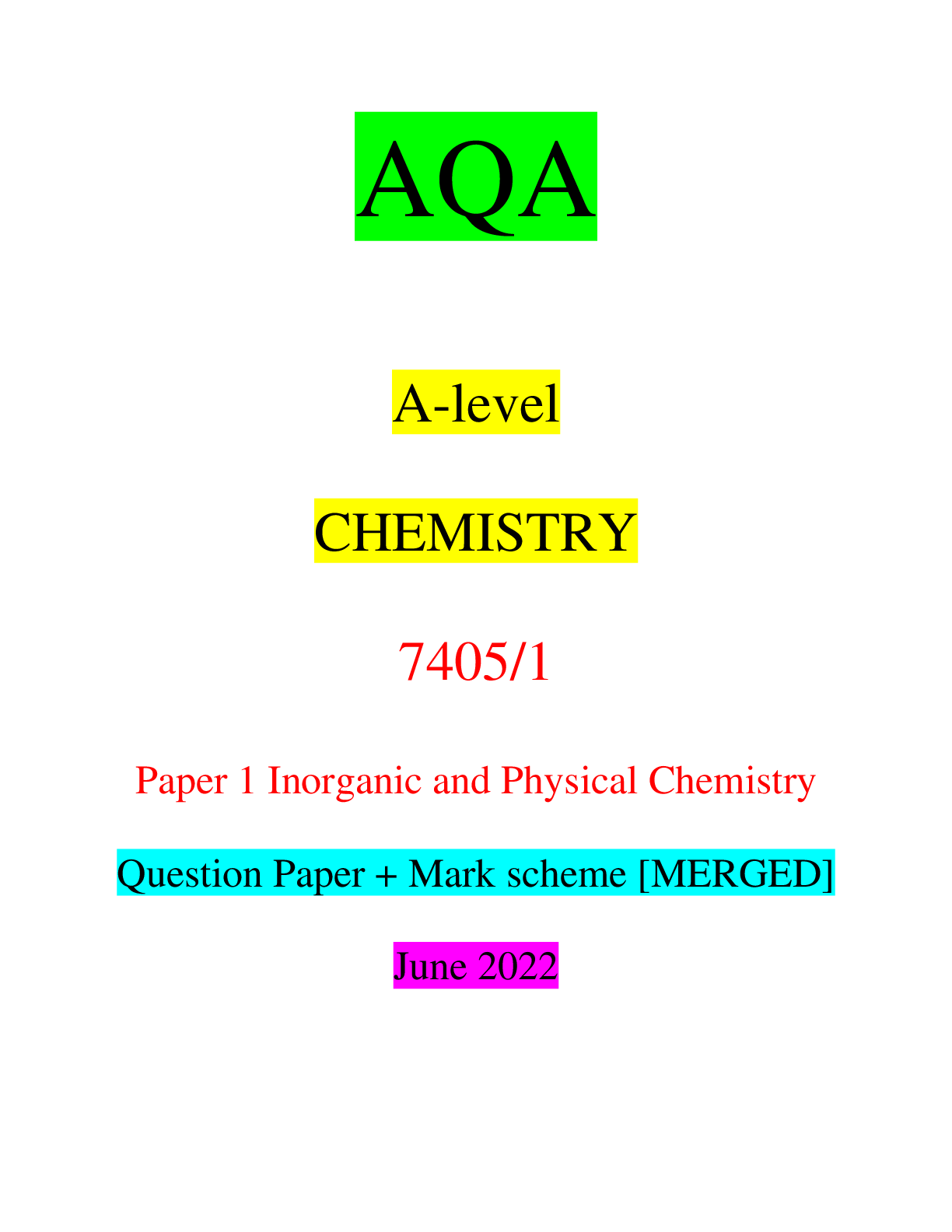
Buy this document to get the full access instantly
Instant Download Access after purchase
Buy NowInstant download
We Accept:

Reviews( 0 )
$7.00
Can't find what you want? Try our AI powered Search
Document information
Connected school, study & course
About the document
Uploaded On
Jun 03, 2023
Number of pages
72
Written in
Additional information
This document has been written for:
Uploaded
Jun 03, 2023
Downloads
0
Views
128

.png)
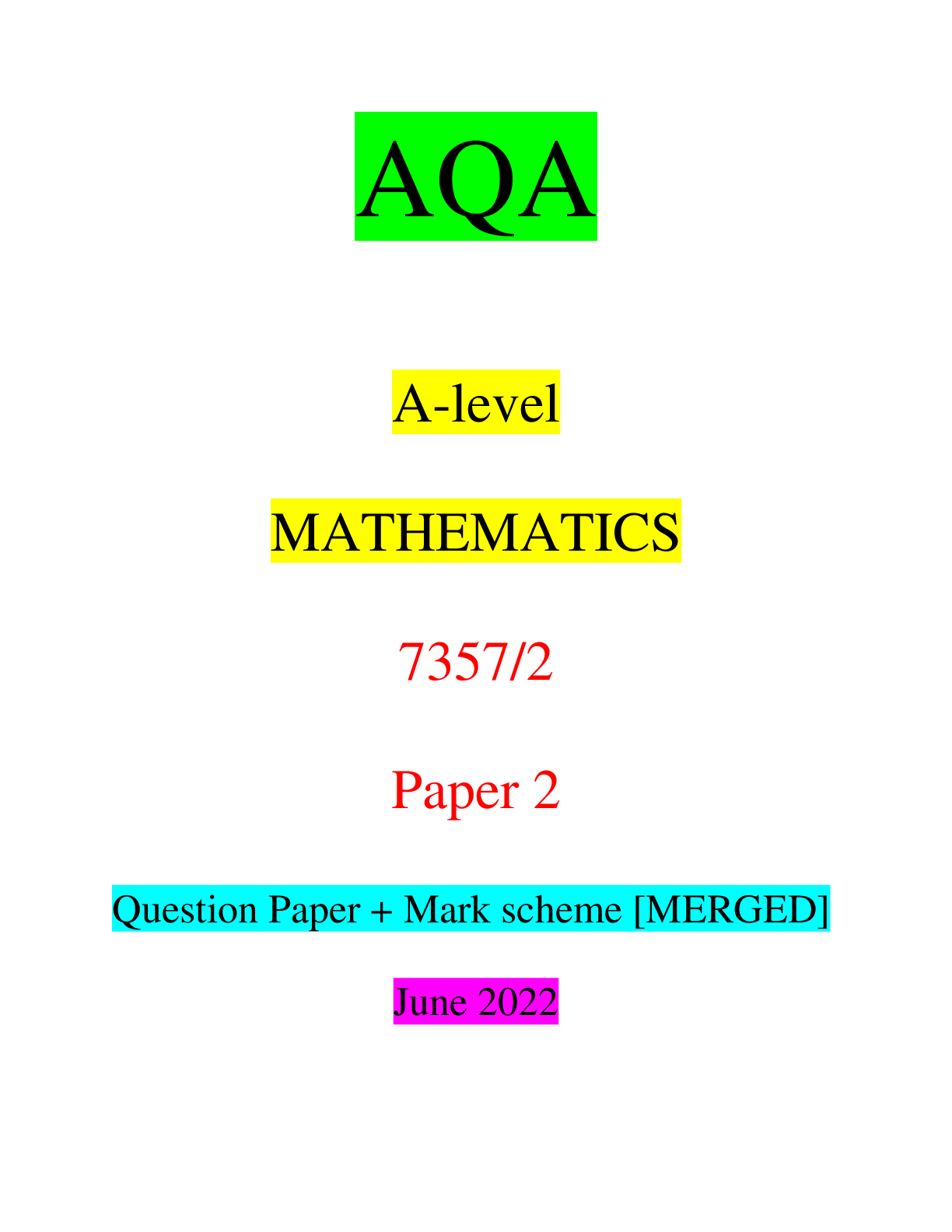
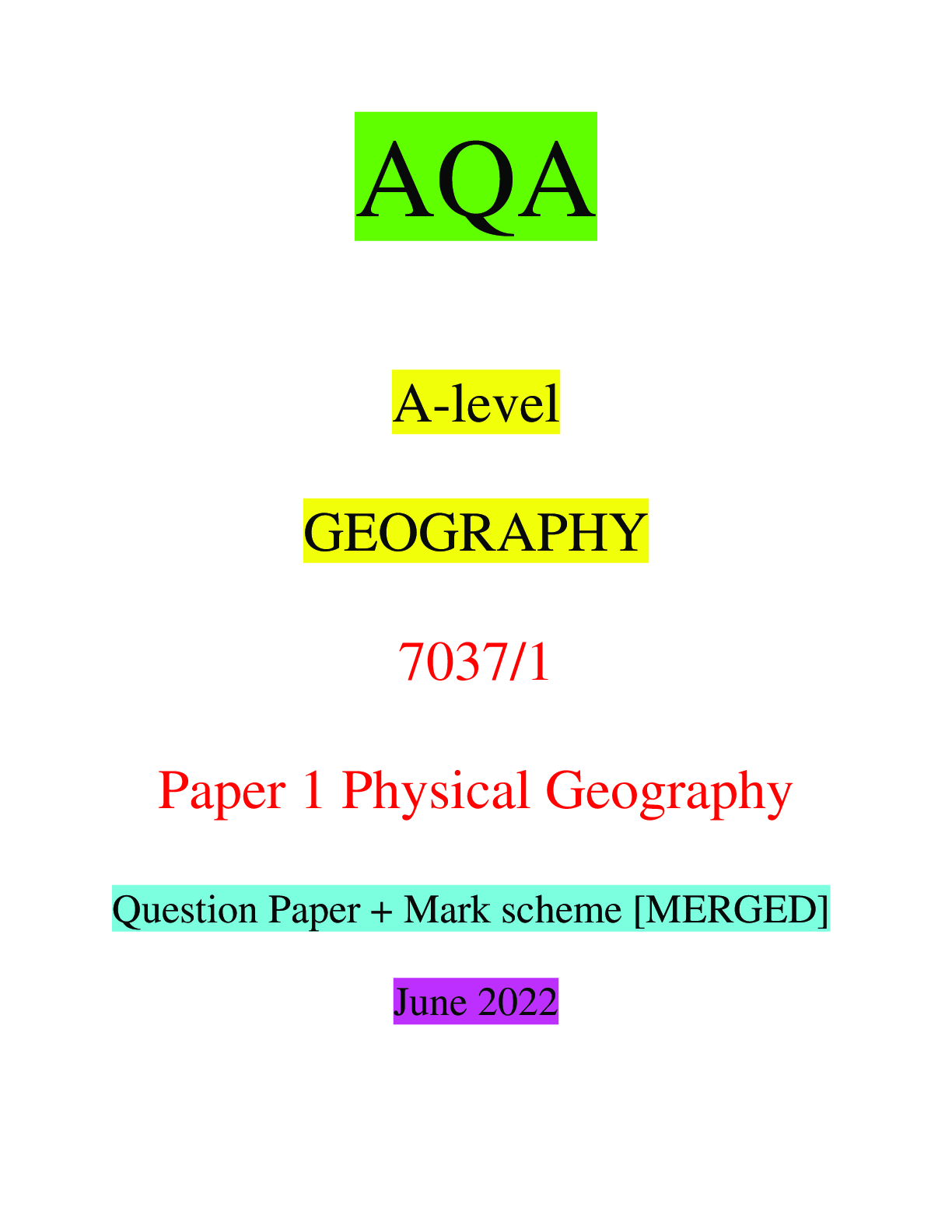
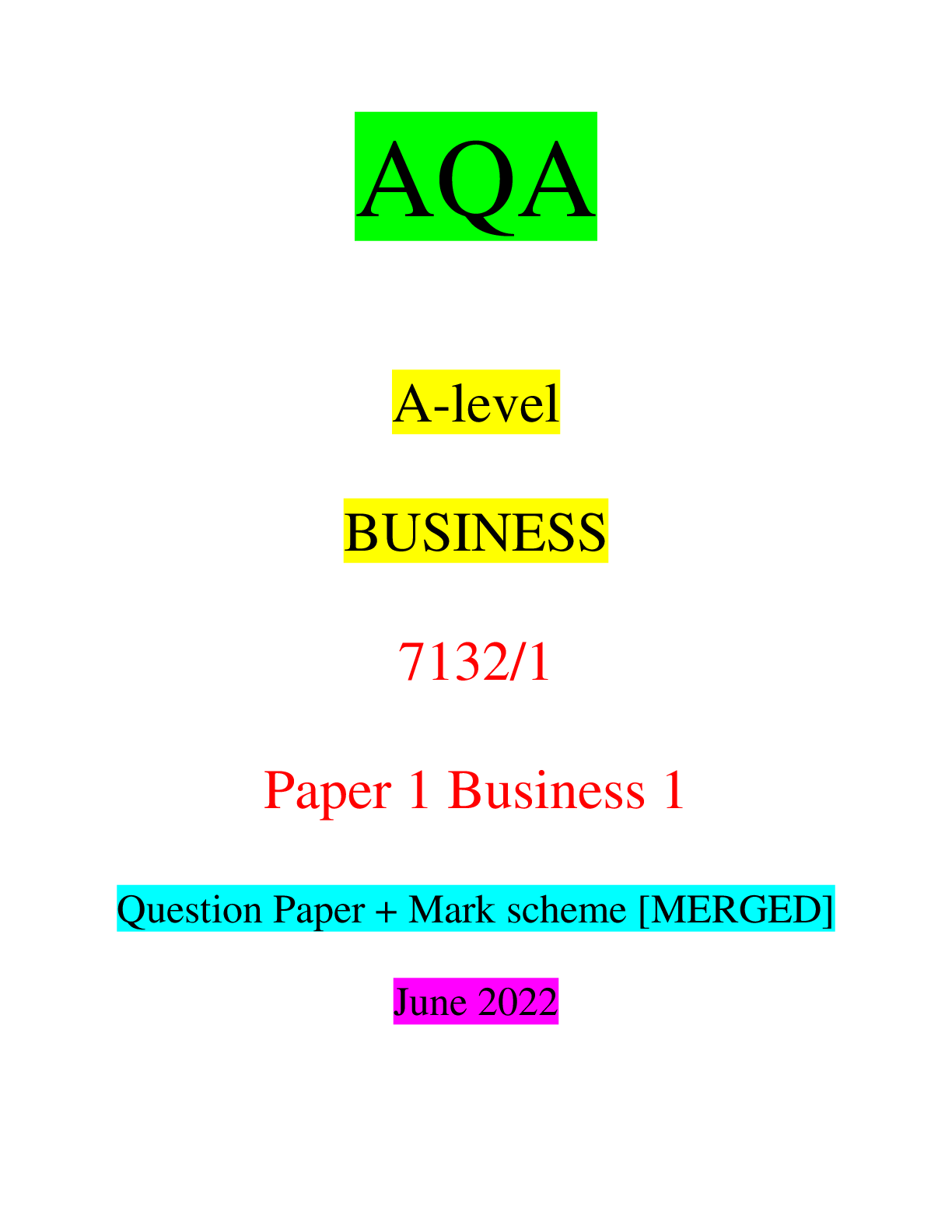
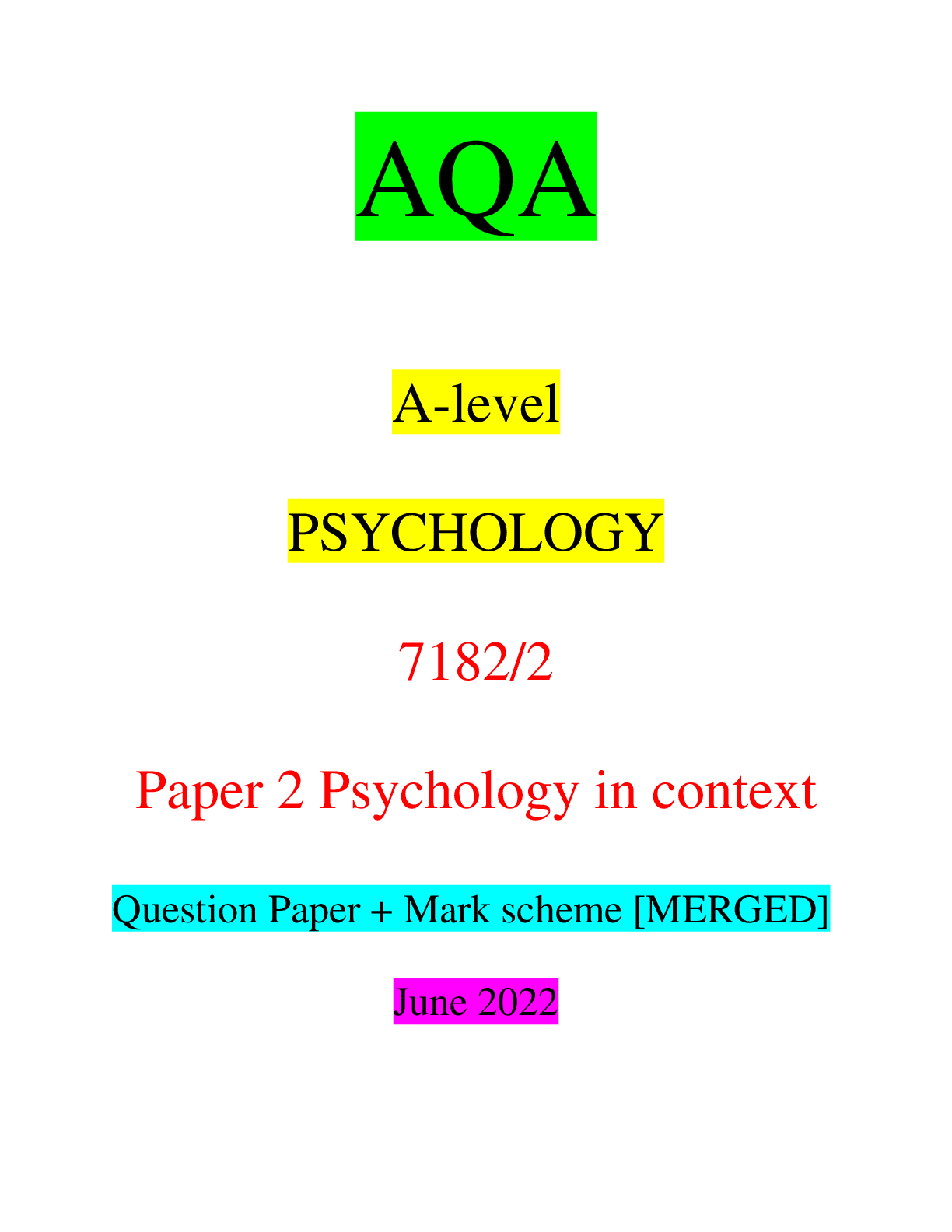

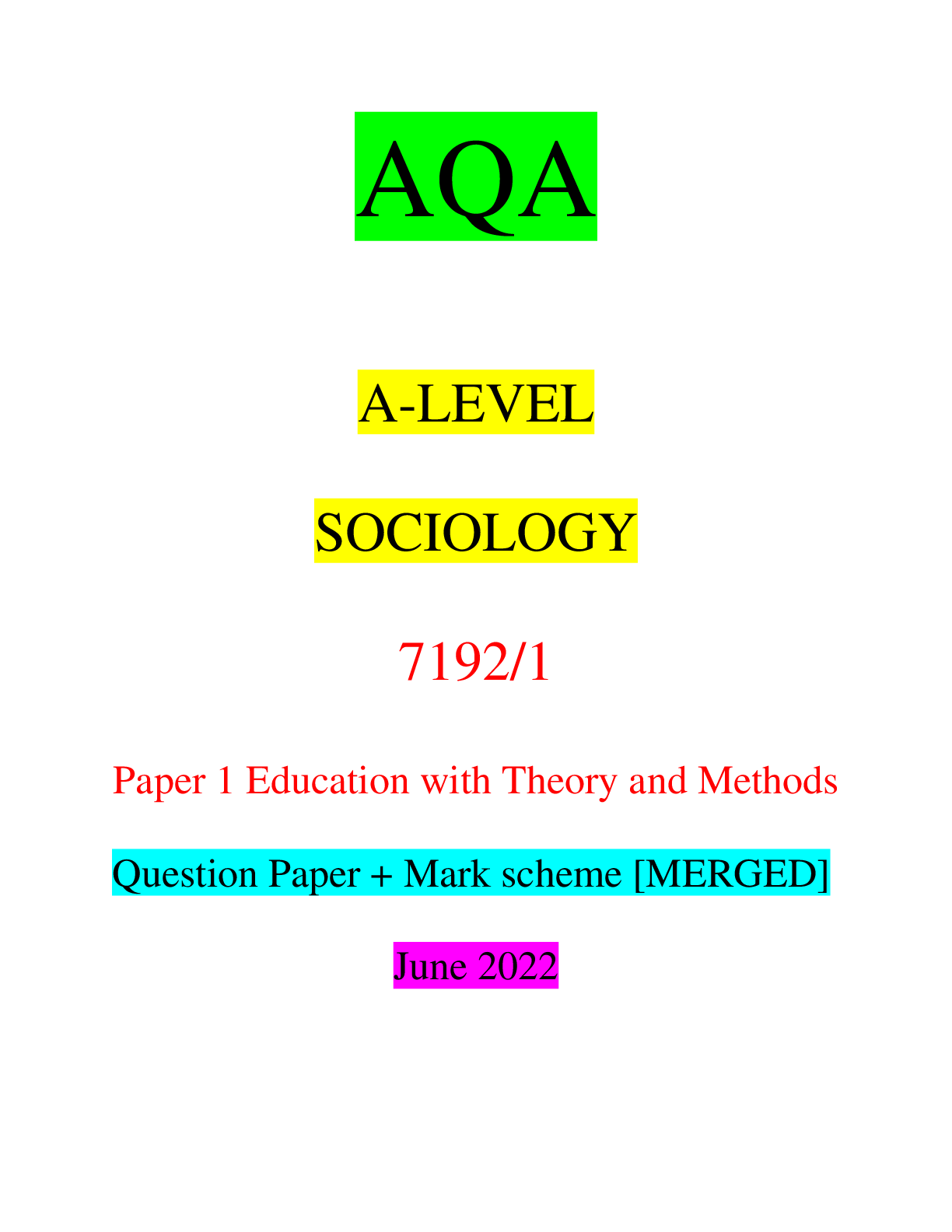
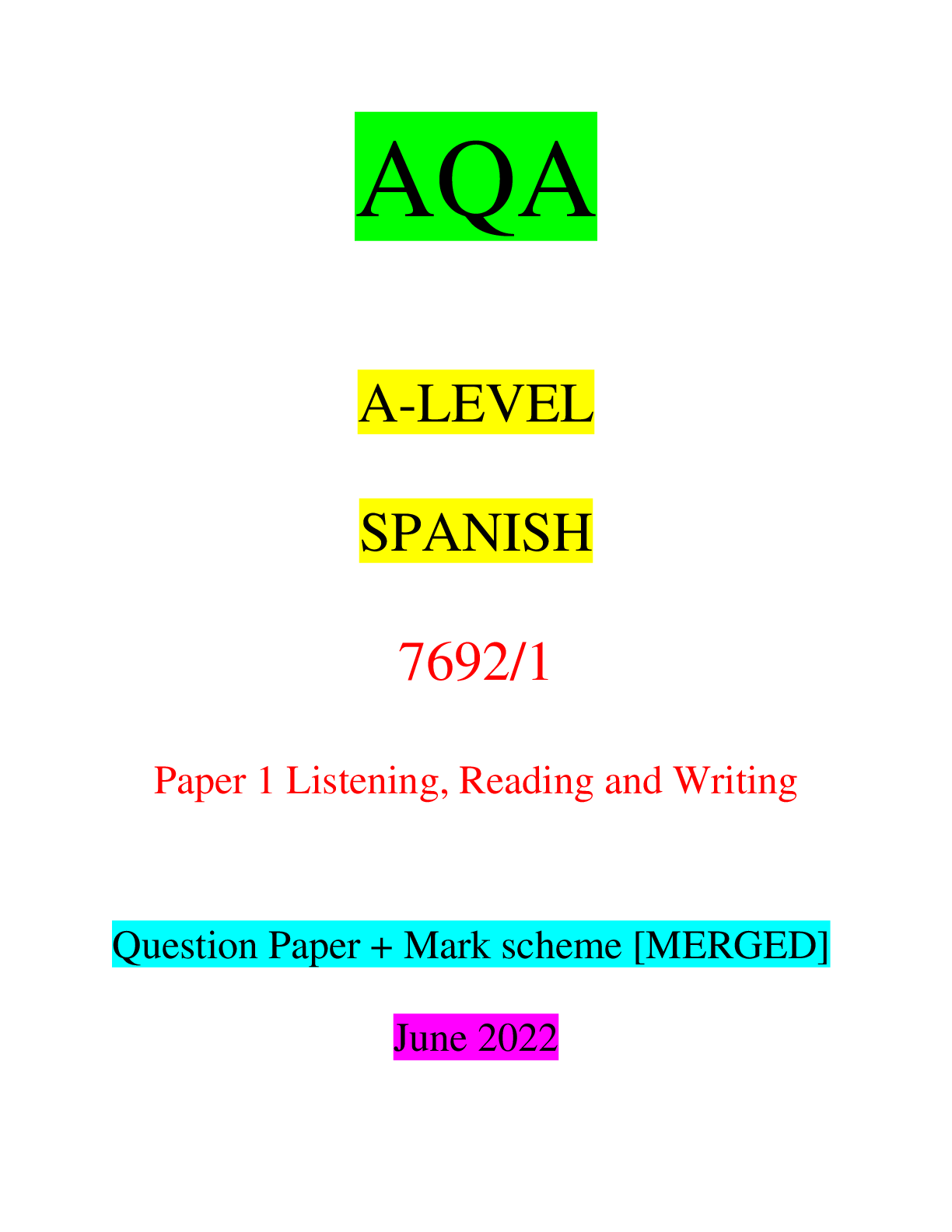
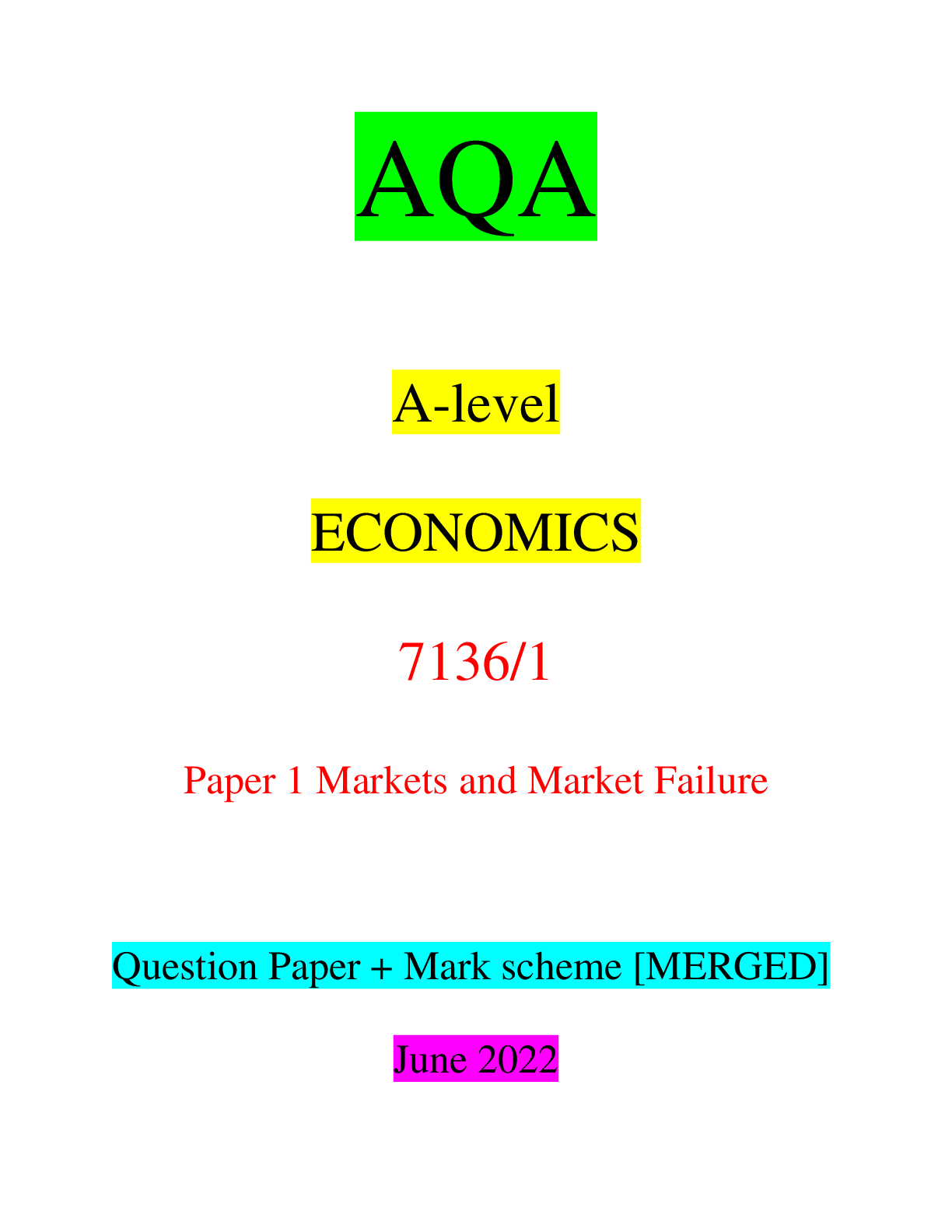
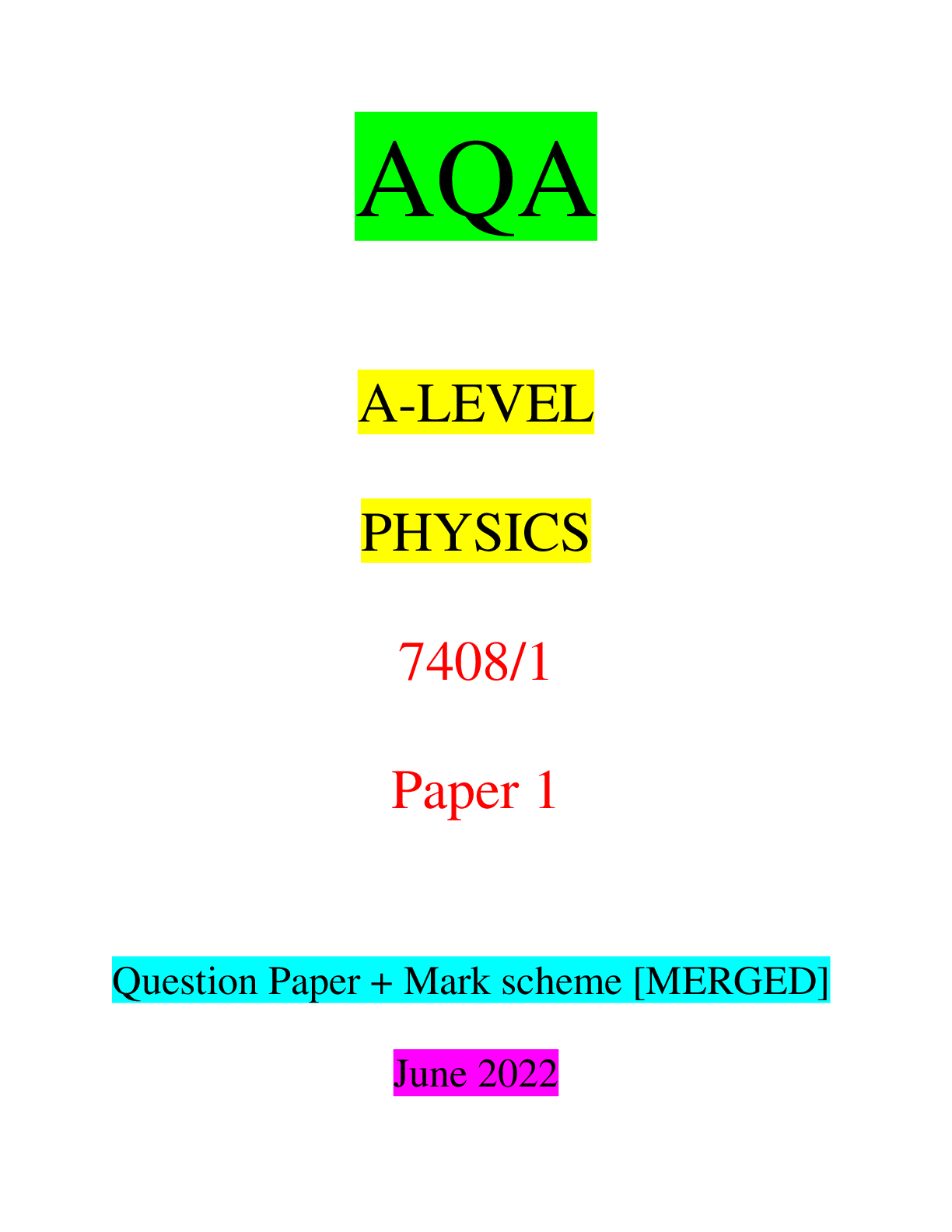
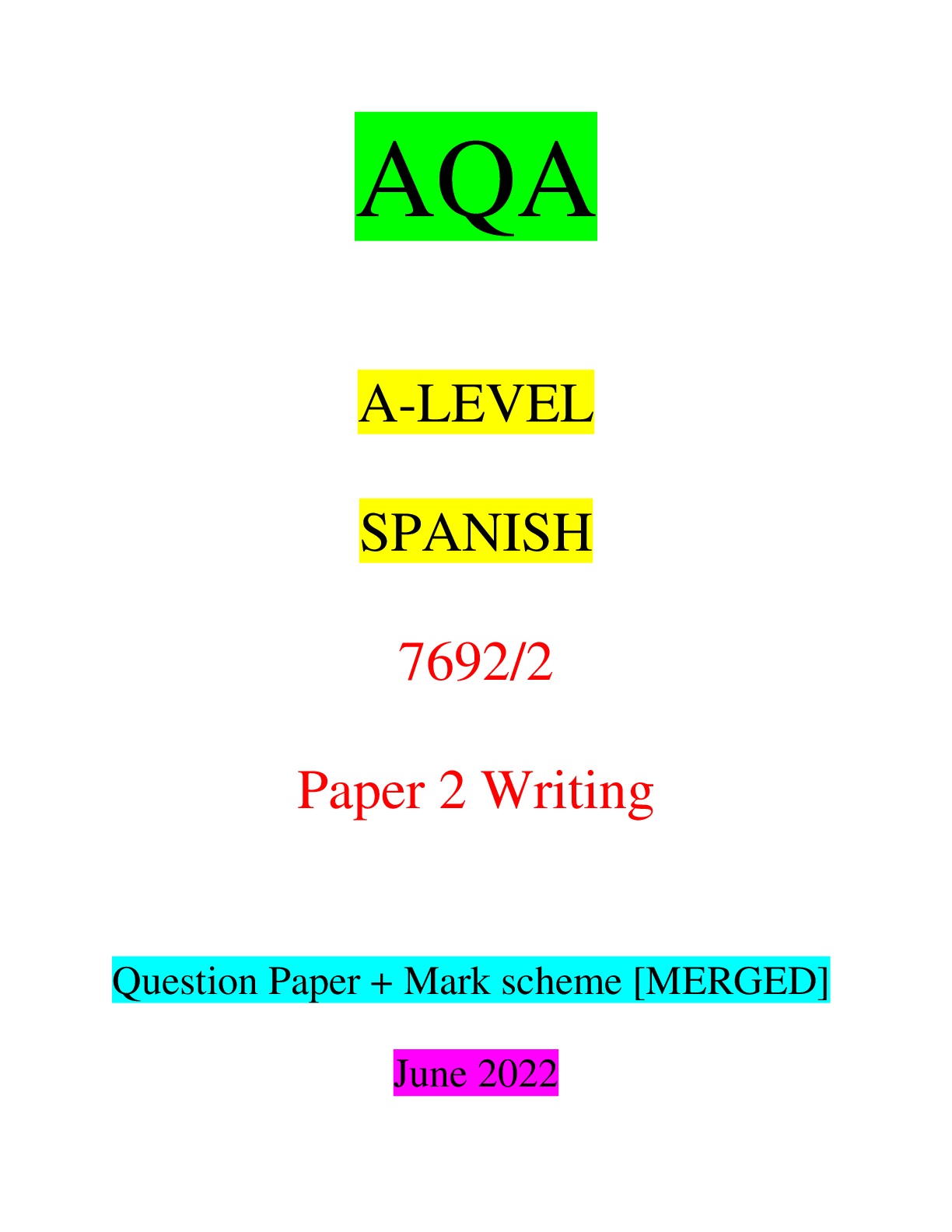


 (1).png)
.png)
.png)
.png)
.png)
.png)
.png)
.png)
.png)

